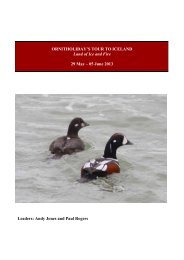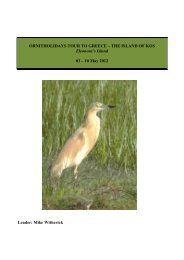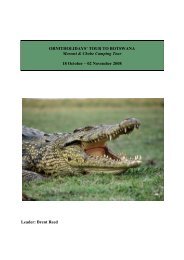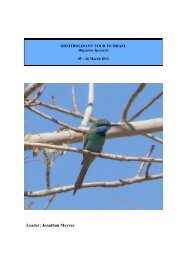Download 2014 Brochure (.pdf) - Ornitholidays
Download 2014 Brochure (.pdf) - Ornitholidays
Download 2014 Brochure (.pdf) - Ornitholidays
Create successful ePaper yourself
Turn your PDF publications into a flip-book with our unique Google optimized e-Paper software.
Kaka<br />
wildlife watching to be done! Wandering and Shy<br />
Albatrosses often pass by, as do giant petrels,<br />
and many shearwaters. Towards the entrance to<br />
the Marlborough Sounds Little Penguins, Spotted<br />
Shags, and sometimes dolphins can often be<br />
seen. A short evening drive will take us to Picton<br />
where we stay overnight.<br />
Days 8 & 9<br />
The waters and inlets of the Marlborough Sounds<br />
will be our playground this morning. A charter<br />
vessel will carry us through Queen Charlotte<br />
Sound to a small rocky islet, where a small colony<br />
of the rare King Shag breeds and roosts. Close by<br />
lies a meeting place of the Tasman Sea and the<br />
Pacific Ocean, where we will be able to see several<br />
pelagic species at close quarters as they swarm<br />
around this rich feeding ground. Before returning<br />
to Picton, we will land to introduce ourselves to the<br />
curious Weka. Later we drive to Kaikoura, where<br />
we stay for two nights. Kaikoura is a breath-taking<br />
place where the continental shelf drops abruptly<br />
very close to shore, resulting in upwellings of<br />
nutrients from the sea’s depths, attracting a rich<br />
and abundant marine life. Marine mammal options<br />
include seeking out Sperm Whales, or Common<br />
and Dusky Dolphins. An excellent opportunity for<br />
birdlovers and generalists alike is a seabird<br />
excursion, where we can see flocks of cawing<br />
albatrosses, and numerous petrels and<br />
shearwaters, just metres from the boat. The<br />
afternoon will be at leisure to stroll on Kaikoura<br />
Peninsula.<br />
Day 10<br />
Our journey carries us across the vastness of the<br />
Canterbury Plains, and over the main divide via<br />
Arthur’s Pass, a route once used by Maori. Blackfronted<br />
Terns are regularly seen on the flats<br />
leading up to the pass, and in Arthur’s Pass<br />
National Park we may encounter the cheeky Kea.<br />
We stay in Arthur’s Pass region this evening and<br />
search for Great Spotted Kiwi tonight.<br />
Days 11 & 12<br />
This morning we will travel down the wild and wet<br />
West Coast on avenues framed by the green<br />
lushness of rainforest. Amongst this landscape is<br />
our next stop, the Okarito Lagoon, where in<br />
gentle wetlands Fernbirds may be found, as may<br />
the striking White-faced Heron, or Great Egret.<br />
We may also venture into the forest, to enjoy its<br />
greenness and perhaps see the New Zealand<br />
Brown Creeper. We stay at Franz Josef two<br />
nights. The next day we have the chance to relax<br />
in the vicinity of the renowned Franz Josef<br />
Glacier with an evening excursion to look for the<br />
endangered Okarito Brown Kiwi.<br />
Days 13 & 14<br />
The next day we travel to Lake Moeraki where a<br />
delightful walk to the coast brings us onto a golden<br />
beach, where a northern colony of the rare<br />
Fiordland Penguin breeds. Later, we leave the<br />
West Coast to travel to Lake Ohau, where we stay<br />
for two nights. The southern beech forests of Haast<br />
Pass may provide us with further opportunities to<br />
view forest species such as the endangered<br />
Yellowhead. Thereafter we leave the forest behind,<br />
journeying through the vast rolling Otago<br />
landscape of schist rock, and the tussock land and<br />
clear turquoise lakes of the MacKenzie Basin. The<br />
braided rivers in this region are the habitat of the<br />
endangered Black Stilt, and we will look also for<br />
Wrybill and a range of inland waterfowl.<br />
Day 15<br />
We have further opportunities to enjoy the inland<br />
waders before the drive down to the east coast<br />
and Dunedin where we stay overnight. We take a<br />
late afternoon cruise down Otago Harbour to<br />
Taiaroa Head. Here at Taiaroa is the only<br />
mainland colony of an albatross species. The<br />
Royal Albatross, one of the world's largest flying<br />
birds, has a small colony. Just below them is a<br />
colony of several thousand Bronze Shags and<br />
near them smaller colonies of Spotted Shags<br />
and Little Pied Cormorants.<br />
Days 16 & 17<br />
We leave Dunedin for Invercargill travelling via the<br />
Catlins coast. We stop at the Tautuku Estuary to<br />
look for Fernbird. In the mid afternoon we take a<br />
flight across to Stewart Island where we stay for<br />
two nights. In the evening we make a trip to view<br />
Stewart Island Brown Kiwi. The next day we take a<br />
charter cruise around the coast of Stewart Island<br />
then out into the Pacific Ocean to look for Shy<br />
Albatross, Sooty Shearwater, Broad-billed Prion,<br />
Mottled Petrel and Brown Skua. The rare Yelloweyed<br />
Penguin may be seen before we return to the<br />
more sheltered waters of Paterson Inlet. We land<br />
on Ulva Island for excellent viewing of most of the<br />
South Island forest birds such as Weka, New<br />
Zealand Kaka, Yellow-fronted and Red-fronted<br />
Parakeets and New Zealand Brown Creeper.<br />
Days 18 & 19<br />
After an early morning flight back to Invercargill<br />
we depart for Fiordland National Park, New<br />
Zealand's largest and grandest national park. The<br />
landscapes are unrivalled in New Zealand and the<br />
Red Beech forests of northern Fiordland are home<br />
to an excellent array of forest birds. They are the<br />
last stronghold of the Yellowhead, while we may<br />
also see an early arriving Shining Bronze-Cuckoo.<br />
We stay at Te Anau Downs for the next two nights.<br />
The next day, weather and snow permitting, we<br />
visit the Upper Hollyford Valley through which the<br />
famed Milford Road passes, which contains<br />
superb subalpine herbfields and boulderfields.<br />
We will look for Rock Wren, one of New Zealand's<br />
more secretive birds, which inhabits the<br />
boulderfields and cirque basins. These are home<br />
to the threatened Kea. There will also be time<br />
today for an optional cruise on Milford Sound.<br />
Days 20 & 21<br />
We return across the southern South Island to<br />
Dunedin Airport for our flight to Auckland where<br />
we connect with the evening flight to London,<br />
where we arrive the next morning.<br />
Outline Itinerary<br />
Day 1 Depart London<br />
Day 2 In transit<br />
Day 3 Arrive Auckland<br />
Day 4 Auckland<br />
Day 5 Taupo<br />
Day 6 Tongariro National Park<br />
Day 7 Picton<br />
Days 8-9 Kaikoura<br />
Day 10 Arthur’s Pass<br />
Days 11-12 Franz Josef<br />
Days 13-14 Lake Ohau<br />
Day 15 Dunedin<br />
Days 16-17 Stewart Island<br />
Days 18-19 Lake Te Anau Downs<br />
Day 20 Depart Dunedin<br />
Day 21 Arrive London<br />
Party Size<br />
Maximum of 12 clients.<br />
Accommodation<br />
Comfortable accommodation in twin/double<br />
and single rooms with private facilities.<br />
Transport<br />
By small coach driven by the leader.<br />
Includes<br />
All flights, meals, accommodation, transport,<br />
entry fees, services of the leaders, airport<br />
taxes and tips.<br />
Gradings<br />
Wrybill<br />
Good<br />
120<br />
Cool to Warm<br />
Low<br />
Normal<br />
Moderate<br />
Good<br />
Easy<br />
Scheduled<br />
New Zealand Pigeon<br />
N E W Z E A L A N D<br />
To make a booking please call <strong>Ornitholidays</strong> on 01794 519445<br />
91








